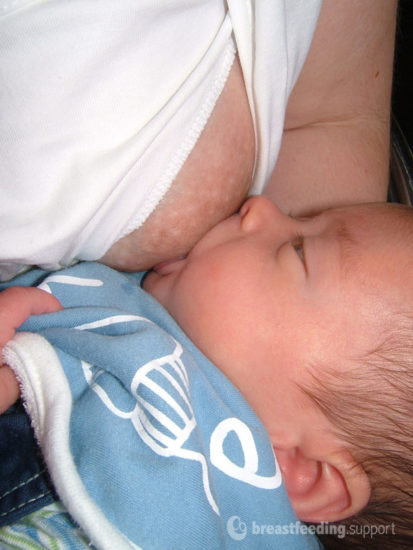A bottle teat is not the same as a breast despite claims by the manufacturers. Breastfeeding uses a different tongue and jaw action to that needed to get milk from a bottle, and skin is not the same as silicone. Sometimes a breastfed baby may begin to fuss at the breast in preference for the faster flow of milk from the bottle (bottle preference). And some babies find it hard to switch between bottle and breast. Some babies may start using a bottle feeding suck on the breast—leading to discomfort for you and frustration for your baby (nipple confusion). This article shares ideas that may help to reduce bottle preference or nipple confusion if you need to bottle feed a breastfed baby.
#1 Recreate a deep latch
The way a baby attaches to the breast is often called the “latch”. In a comfortable or deep latch, a baby will attach to the breast with a big mouthful of breast tissue as well as the nipple so that the nipple is deep in their mouth. Recreating the wide-mouthed jaw position seen with breastfeeding is thought to help prevent nipple confusion or nipple preference. To recreate this with a bottle try:
A short or medium length teat with a medium sized base
A short or medium length bottle teat with a rounded tip and a medium-wide base can allow a baby to take most of the bottle teat in his mouth close to the screw cap. This will give him a wide open mouth around the base of the bottle teat and the tip of the teat will be deep in his mouth in the same position as the nipple during breastfeeding. The photographs below from Latching Tips show the kind of wide open mouth you can try and recreate on the base of a bottle teat.
Artificial nipples with a long narrow teat and/or a very wide base may force your baby to make a small mouth around the narrow length of the nipple similar to the mouth position when sucking on a straw. This could create bad habits with your baby’s latch when they breastfeed.
Trial and error
Be aware that the branding of bottles is not very reliable. Claims that one is closer to breastfeeding than another can usually be disregarded. Look for a bottle teat that suits your baby. You may need to try a few different teat shapes to see which works best to prop your baby’s mouth wide open with the bottle teat deep in his mouth. See Best Bottle for a Breastfed Baby? for more information about shapes and characteristics of teats that can support or undermine breastfeeding.
#2 Encourage rooting and gaping
Encouraging the rooting reflex and waiting for a wide gape before your baby takes the bottle teat in his mouth replicates how a baby takes a big mouth full of breast (not just the nipple). Brushing your baby’s lips gently with the tip of the bottle nipple will trigger his reflex to open his mouth to search for the nipple. When he opens his mouth at its widest point, offer the teat and encourage your baby to take the entire artificial nipple into his mouth close to the cap. If the bottle nipple is too long for your baby’s mouth, this could make him gag, so be guided by your baby and choose a shorter teat if needed.
#3 Switch sides
Breastfeeding usually involves switching breasts either part way through a feed or at the next feed. To replicate this you could hold your baby in the opposite arm to have the second half of their bottle or turn him on to his other side if he is side-lying (see below). This can help to maintain a baby’s willingness to feed in all directions at the breast and may be beneficial for normal eye development.
#4 Mimic the first let-down
At the breast your baby usually has to wait a minute or two for the milk ejection reflex or “let-down” to trigger plentiful flowing milk. Holding the bottle horizontally so milk doesn’t fill the teat for the first few sucks copies the waiting time before the let-down.
#5 Slower milk flow
Bottle teats can often provide milk faster than a breast which some babies may like—and can lead to babies preferring the bottle over the breast. If the flow is very fast however, it can also be stressful for your baby to try and keep up with the fast flow (see the stress cues discussed in #6 below). There are several ways to help avoid either bottle preference or distress from a fast flow:
Slow-flow teats
Slow-flow bottle teats will usually be closer to the rate of milk flow during breastfeeding. However, be aware that the claims and branding around bottle nipples can mean very little. A teat may be marked as slow flow but be very fast and vice versa1. The rate that milk drips from the teat when the bottle is held vertical is also not a reliable guide to the rate of flow when baby sucks. Avoid a teat that delivers milk so quickly that it causes your baby to be overwhelmed causing him to gulp, choke, spill lots of milk or show other more subtle signs of stress.
Baby’s body position
Milk automatically drips from most bottles when they are held upside down (vertically). A baby can’t control the milk flow from a bottle if he is lying flat on his back and milk is dripping down into his mouth even when he doesn’t suck. If a baby is on his back he will have to keep swallowing to keep up with the milk flow until the bottle is finished. This could be one of the reasons bottle feeding is linked with over feeding and obesity 2 and it can be stressful for the baby. Upright positions and side-lying positions can be helpful.

Upright positions. Holding a baby so that they are either supported at a 45° angle or in more of an upright position can help them to control the flow of milk into their mouth.
Side-lying. A side-lying position can work well for a younger baby (see video below). The carer can tilt the bottle just enough to keep the artificial nipple filled with milk. As the bottle empties, take care not to hyperextend the baby’s neck and check for signs that the flow of milk is not uncomfortably fast for him.
Bottle feeding a baby in a side-lying position:
Pace the feed, allow pauses
During breastfeeding, babies are in control of milk flow after the initial let-down; when they stop sucking, milk will stop flowing. It is not so easy for a bottle-fed baby to pause, take a break or decide that he is full if milk is dripping quickly from the bottle of its own accord. When the bottle is more horizontal a baby will have to suck more actively because gravity won’t be helping to pour milk into his mouth. By changing the angle of the bottle at intervals, a baby can take pauses when he needs them, rather than having a continual stream of milk from start to finish. Controlling milk flow in this way is often referred to as “paced feeding” or “pacing the feed”.34 Paced feeding can help a baby recognise when he is becoming full and prevents overfeeding (see video clip below).
Video clip showing how to pace a bottle feed:
#6 Watch baby for signs of stress
Not too fast
If the flow of milk is too fast, a baby may show signs they are stressed and the ideas in #5 above can be used to slow the flow. Signs of stress can be very subtle: for example frowning, looking wide-eyed or holding hands up with splayed fingers. Other indicators such as gulping, not pausing to take a breath, or becoming cyanosed (blue in colour) can also indicate milk may be flowing too quickly.
Not too slow
There is no need to slow the flow down unnecessarily so that your baby is frustrated— the pace can be “baby-led”. In particular, slowing the flow unduly is not appropriate for underweight babies with growth faltering who may need encouragement to feed in the easiest way possible.
Help! My baby prefers the bottle
The tips above can help to reduce or avoid breastfeeding problems but sometimes you may find that your baby still starts fussing at the breast and seems to prefer a bottle. Or you may begin to notice changes to your baby’s latch when you breastfeed. If your baby is fussy at the breast or refusing to breastfeed you could try:
- Cutting back on using a bottle for a while to get breastfeeding back on track and see the ideas in How to Get Baby Back to the Breast
- Breast compressions to increase the flow of breast milk if they are frustrated with a slower flow at the breast
- If you are using a bottle to top up your baby due to low weight gain, and they are starting to fuss at the breast The “Finish at the Breast” Method of Supplementation described by Diana West and Lisa Marasco may be useful.5 This involves returning your baby to the breast to finish off their feed after having their top up. They then associate the breast with feeling full and may have more patience for a slower flow. Once your baby is gaining well and is stronger he may be able to take his supplement with a supplemental nursing system at the breast.
My baby has nipple confusion
If your baby’s latch seems to be affected despite trying the ideas above, cutting back on bottles for a while can help to reinforce your baby’s breastfeeding skills and review the principles of good attachment in Latching Tips. Alternatives to bottle feeding such as cup feeding or using a supplemental nursing system at breast or via finger-feeding can be discussed with your health professional and lactation consultant if bottles are interfering with breastfeeding.
Summary
Although some babies will happily switch between breast and bottle without any problems, bottle feeding can undermine breastfeeding if using a bottle changes the way a baby breastfeeds or if a baby begins to prefer a bottle due to a faster flow of milk. There are lots of ways to try to make a bottle feed more like a breastfeed and reduce bottle preference or nipple confusion. Cup feeding or breastfeeding with a supplemental nursing system can be alternative options to consider for supplementing a baby.

